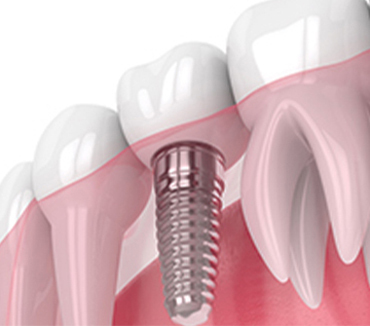The Ultimate Guide to Dental Implants: Types, Procedure
Feeling like your smile is incomplete? If you’re looking to replace missing teeth, dental implants are a great option to help you get the smile of your dreams. Not only can dental implants improve the look of your smile, but also your ability to speak and chew the foods you enjoy.
Dental implants have become increasingly popular overtime, with the first one being placed dating back to1965. Dental implants are surgically placed into the upper or lower jaw, and a natural artificial tooth crown is placed into the screw-like post.

What is Dental Implant?
Dental implants are small posts with a natural artificial tooth that is designed to remain stable within the jaws and replace missing teeth. These tooth replacements can help keep other teeth from shifting out of place, and will help maintain the overall look and function of your smile.
Dental Implant Statistics
- According to the Centers of Disease Control and Prevention (CDC), an average of 12 teeth have been lost by most Americans by age 50.
- Studies have shown a 95% success rate for replacing teeth with dental implants.
- The popularity of dental implants continues to increase, with the market expecting to grow at a compound annual growth rate of 10% to $9.08 billion in 2026.
Types of dental implants
Endosteal implants
Endosteal implants are the most common type of implant used, according to the American Academy of Periodontology. They can be in the shape of a screw or blade, and are typically made of titanium. These implants are placed into the jawbone, which overtime becomes fully incorporated into the bone. Once healed, a connecting piece called an abutment is placed on top of the implant, which allows the artificial tooth to connect and replace your missing tooth.
Subperiosteal implants
Subperiosteal implants are inserted on top of the jawbone just below the gums. Subperiosteal implants are often recommended for individuals who have significant bone loss in the jaws, or for those with an altered jaw shape that won’t sufficiently support an endosteal implant.
Transosteal Implants
Transosteal implants are less common, as the procedure can often be more extensive than the other types of dental implants. This option is typically used when there is not enough bone support for endosseous or subperiosteal implants. A metal plate is inserted into the lower jawbone with posts that poke through the gums to support the artificial teeth.
Single vs Multiple
Single Tooth Dental Implants
Single tooth dental implants replace one missing tooth. A patient can have multiple single tooth dental implants in different areas of the mouth. It is made up of the metal screw, an attaching abutment piece, and an artificial tooth.
Multiple Tooth Dental Implants
Multiple tooth dental implants help replace multiple missing teeth. Your dental professional will determine the number of dental implants necessary to adequately support a prosthetic restoration such as a dental bridge or complete denture.
Full Mouth Dental Implants
Full mouth dental implants can help replace all missing teeth in one or both jaws. As with multiple tooth dental implants, a set number of dental implants will be determined by your dentist depending on your individual case. In some instances, only four dental implants are needed to support a complete denture for a jaw that is missing all teeth.
Alternative to dental implants techniques
Sinus Augmentation
- Is a procedure performed to add bone tissue to the upper jaw prior to dental implant placement.
Ridge Modification
- This procedure is performed to reshape the jaw and gums for better support of a dental implant.
Immediate Load Dental Implants
- This technique involves placing a restoration within 48 hours of dental implant placement.
Mini Dental Implants
- Mini implants are used when space requirements require a smaller implant size, as they are smaller than traditional implants.
All-on-4 Dental Implants
- All On 4 dental implants are a method to replace all missing teeth in the upper or lower jaw with the use of 4 implants.
Basal Implants
- Basal implants are dental implants that are placed within the basal parts of the jawbone.
Zygomatic Implants
- Zygomatic implants are dental implants that are placed in the zygomatic bone of the upper jaw.
Pterygoid Implants
- Pterygoid Implants are placed in the pterygomaxillary region of the upper jaw.
Blade-form Implants
- Blade-form implants are a type of endosseous dental implant that is placed within the bone.
Ramus Frame Implants
- Ramus frame implants is a type of endosseous implant that is placed in the lower jaw.
Guided Bone Regeneration (GBR)
- Guided bone regeneration (GBR) is a procedure that corrects small jaw bone defects using bone grafts with barrier membranes.
Socket Preservation Technique
- Socket preservation technique involves placing a bone immediately after tooth extraction to help prevent bone loss.
Who needs dentle implants?
Dental implants are greatly beneficial for individuals who:
- Are missing one or more teeth.
- Have a stable oral health condition.
- Want to improve eating, speaking, and self-confidence.
- Do not smoke tobacco.
- Are committed to improving oral health.
- Do not have any remaining growth potential.
- Have adequate bone or are able to have a bone graft procedure to support dental implants.
- Medically clear of any health conditions that affect bone healing.
- Are looking for alternative options to dentures.
Benefits of dental implants over other tooth replacement options
There are many benefits to dental implants. Dental implants both look and behave like natural teeth, helping you to chew and speak normally. Plus, when taken care of properly, dental implants can potentially last a lifetime.
Dental implants can help prevent bone loss that would naturally occur if the missing tooth was not replaced. Another benefit is that dental implants can help keep neighboring teeth from shifting and maintain your bite.
What are the risk factors of dental implant?
Although rare, risk factors of dental implants can include:
- Infection around the implant leading to inflammation and potential bone loss.
- Damage to blood vessels, teeth, or other oral tissues.
- Nerve damage resulting in pain, numbness, or a tingling sensation.
- Sinus issues in cases where implants are placed in the upper jaw.
How to Prepare For Dental Implants
Comprehensive dental exam
To determine if you are a candidate for dental implants, a comprehensive exam with dental X-rays and models made of your teeth and jaw will be performed. Your dental professional will review your medical and dental history. Be sure to inform your dentist of any medical conditions and medications you take. They will also inform you if additional procedures are necessary to accompany your dental implant placement, such as a bone graft.
X-rays and 3D scans
Dental X-rays and 3D scans are necessary for the placement of dental implants. This allows them to evaluate your bone and to ensure adequate placement of the dental implants.
Oral hygiene
Your oral hygiene must be adequate before, during, and after the process of dental implants. Poor oral hygiene is a contraindication for dental implants, as this can increase your risk for infection and it will not allow the implant to properly heal in the bone.
Quit smoking
Smoking is detrimental to both your dental and overall health and can greatly impact the healing process of dental implants. Smoking must be discontinued at least 6 weeks before and after implant surgery to allow for the implants to properly heal in the bone.
Medications
As mentioned, inform your dental professional of any medications you are taking prior to implant therapy. Your dentist will coordinate with your primary care provider to determine whether any of your current medications need to be stopped or altered prior to implant surgery.
Anesthesia
To make the implant process as smooth and comfortable as possible, your dental professional will use anesthesia to help numb the area. They will discuss all surgical anesthesia and sedation options with you prior to your procedure.
Post-Procedure Care
Treatment plan
After the dental implant is placed, your dentist will give specific oral hygiene instructions and inform you about the next steps in the process. Once the dental implant has securely attached to the bone, you will be scheduled for another appointment to place another part of the implant, known as the dental abutment. Later, the artificial tooth will be secured to the abutment.
Recovery time
Recovery time can depend on the type of dental implant surgery and for each individual person. In general, recovery time is approximately 1-2 days. Recovery may take slightly longer if a bone graft was performed. In addition, factors like age, oral health status, and certain medical conditions can make recovery time vary from person to person.
Dental implants procedure
Consultation and evaluation
The first step to preparing for a dental implant is to schedule a consultation with your dental professional. After a thorough exam is complete, your dentist will explain the best implant option to tailor to your needs.
Dental implant placement
After numbing the area for comfort, your dentist will secure the implant into the jawbone. They typically will use a surgical guide to help during the placement process.
Osseointegration process
Once the implant is placed, the jawbone heals around the implant, helping to hold it in place. This process is called osseointegration and can take up to several months.
Abutment placement
A connecting piece called an abutment will be placed once the the healing and osseointegration processes are complete. The abutment allows for the connection between the implant screw and the artificial tooth.
Placement of a dental crown
One of the final steps in the dental implant procedure is placing the artificial tooth. This is also referred to as a dental crown, which is designed to mimic your other natural teeth. A temporary crown, bridge, or denture is often used while a lab fabricates the permanent restorations.
Average Cost of Dental Implants
Although dental implants can be relatively expensive, the all-around success of dental implants makes it well worth the investment. Dental implants can vary in cost, ranging on average from $3,000-$6,500 per tooth. The high price reflects the materials necessary to complete the procedure and the surgical placement process. Some dental insurance plans may help cover some portion of the dental implant costs.
Cost of Single Implant
If you are replacing one missing tooth, a single dental implant on average range from $3,000 to $4,500, according to the American Academy of Implant Dentistry.
Cost of Multiple Implants
For individuals missing multiple teeth, dental implants can be used to support a dental bridge, or a single removable denture. The average cost of multiple implants can vary depending on the number of implants needed. In general, when using multiple implants to support dental restorations, the overall cost per single implant is slightly lower than the cost of a single implant procedure. For instance, the average range per single-tooth implant often decreases to $2,500 to $5,000, depending on multiple factors.
Cost of Full Mouth Dental Implants
Full mouth dental implants can refer to using multiple dental implants to support individual crowns and bridges. Or, it can mean using multiple dental implants to support a complete denture in cases where all natural teeth are missing. The cost of full mouth dental implants on average range from $20,000 to $50,000 per jaw.




